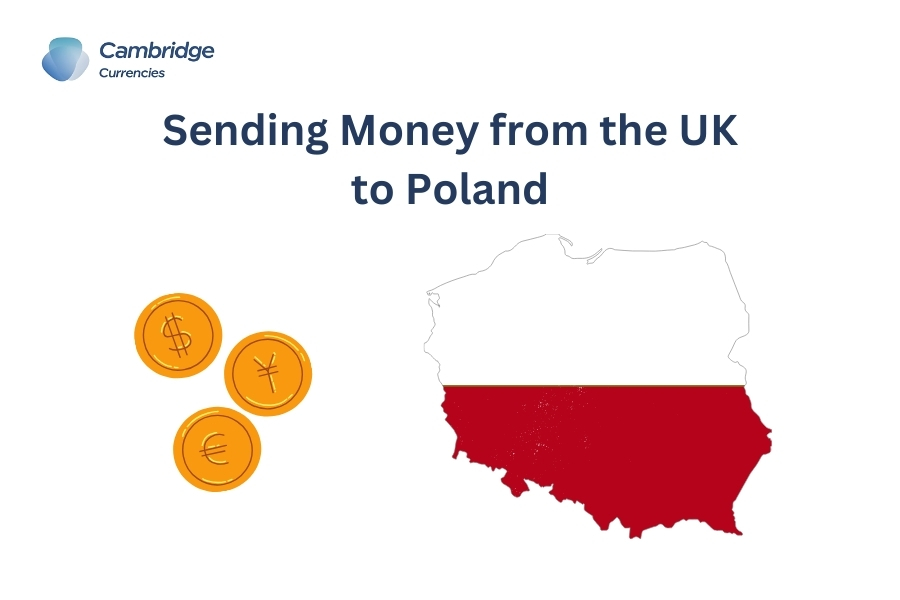Sending Money from the UK to Poland: A Comprehensive Guide
Sending money internationally can sometimes feel complex, but with the right information, it becomes much easier. This guide helps you transfer money from the UK to Poland. It covers the methods and costs. You will also find key tips to ensure your funds reach their destination safely and efficiently.

What Are My Options for Sending Money from the UK to Poland?
There are several ways to send money from the UK to Poland, each suited to different needs. Here are the main options:
1. Bank Transfers
Most UK banks offer international money transfers to Poland. You’ll need the recipient’s bank account details, including:
- IBAN (International Bank Account Number)
- SWIFT/BIC Code
Transfers via banks are secure but may incur higher fees compared to other methods.
2. Online Money Transfer Services
Services like Cambridge Currencies will offer cost-effective transfers at good rates. They will also provide same-day sending on large value transactions.
3. Money Transfer Operators
Companies like Western Union or MoneyGram allow you to send cash to Poland. The recipient can pick up the cash in person. These are ideal for those without a bank account but may involve higher fees.
4. Cryptocurrency
If both you and the recipient are comfortable using cryptocurrency, this can be an alternative. However, it requires familiarity with digital wallets and exchanges.
How Long Does It Take to Send Money to Poland?
The time it takes to transfer money to Poland depends on the method you choose:
- Bank Transfers: 1–3 working days, though some banks offer same-day processing for a higher fee.
- Online Services: Typically within 1 business day; some platforms offer instant transfers.
- Cash Transfers: Minutes to a few hours, depending on the provider.
- Cryptocurrency: Nearly instant, though converting crypto to local currency may take longer.
What Are the Costs Involved?
The cost of sending money to Poland varies based on the method, the amount, and the provider. Here’s a breakdown of potential charges:
- Transfer Fees
- Banks: £10–£30 per transfer.
- Online Services: £0–£10, often with percentage-based fees for large amounts.
- Cash Transfers: Higher fees, especially for urgent or high-value transfers.
- Exchange Rate Markups
- Banks often apply a markup to the exchange rate, making transfers more expensive.
- Online services typically offer mid-market rates or minimal markups.
- Receiving Fees
- Some Polish banks may charge a fee for receiving international transfers, so it’s worth checking with the recipient’s bank.
Do I Need the Recipient’s Bank Details?
Yes, for most transfer methods, you’ll need the following details:
- Recipient’s Full Name
- IBAN (specific to Polish bank accounts)
- SWIFT/BIC Code (to identify the recipient’s bank)
- Bank Name and Address (optional, but helpful for accuracy)
For cash transfers, you typically only need the recipient’s name and a valid form of ID for pickup.
Can I Send Money to Poland for Free?
While it’s difficult to send money completely free, some providers offer fee-free options under certain conditions:
- Promotional Offers: Some online services provide free transfers for new users.
- Revolut and Wise: These platforms often waive fees for smaller amounts or for transfers made in specific currencies.
- Bank Account Transfers: Some UK banks have agreements with Polish banks that minimize or eliminate fees for specific account holders.
How Do Exchange Rates Impact My Transfer?
Exchange rates play a crucial role in determining how much the recipient will receive. Even small differences in rates can have a significant impact, especially for large transfers.
Key Tips:
- Compare exchange rates across multiple providers before sending.
- Use services like Wise or XE, which often offer better rates than banks.
- Lock in favorable rates using tools like forward contracts or alerts if you regularly send money.
What’s the Best Method for Small or Large Transfers?
- For Small Transfers: Online services like Wise or Revolut are ideal due to low fees and competitive exchange rates.
- For Large Transfers: Bank transfers or specialized currency brokers may offer better security and rates for high-value transactions.
Are There Any Regulations or Limits?
Yes, there are a few considerations when sending money from the UK to Poland:
- Regulations:
- UK and EU anti-money laundering laws require identification for large transfers.
- You may need to declare transfers over a certain threshold, depending on the provider.
- Limits:
- Some services impose daily or monthly limits, so check these in advance.
- Banks and brokers often handle larger transfers with fewer restrictions.
What Are the Risks of Sending Money Internationally?
While most transfers are safe, it’s important to stay vigilant to avoid common pitfalls:
- Fraud and Scams: Only use trusted and regulated providers.
- Hidden Fees: Check the full cost, including exchange rates and receiving fees.
- Delays: Double-check recipient details to avoid delays caused by errors.
How Can I Ensure a Smooth Transfer?
Here are a few tips to ensure your transfer goes smoothly:
- Double-Check Details: Verify the recipient’s IBAN, SWIFT code, and name to avoid errors.
- Compare Providers: Use comparison tools to find the best rates and fees.
- Plan Ahead: For non-urgent transfers, start early to avoid paying for expedited services.
- Use Secure Platforms: Ensure the service you choose is FCA-regulated for added peace of mind.
Conclusion
Sending money from the UK to Poland doesn’t have to be complicated. You have various options available. These range from traditional banks to modern online platforms. Choose a method that fits your needs in terms of speed, cost, and convenience. By understanding the process, comparing providers, and staying vigilant, you can ensure your money arrives safely and efficiently.
